#arturia keylab 49
Text
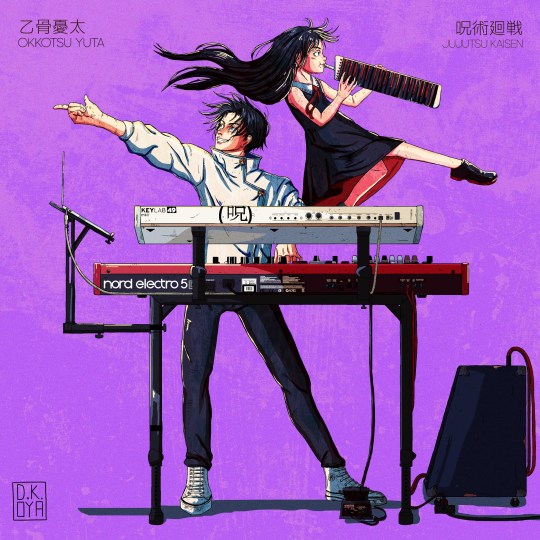
Yuta and Rika dispelling curses with the power of music. :D
I think Yuta would be a pretty flashy keyboardist not on purpose but probably because he's a virtuoso and just can't help but do crazy shit.
His gear are: Arturia Keylab 49 mk II, Nord electro 5D. I forgot what the amp was but I think it was a Roland. Rika is playing a Hohner melodica.
10 notes
·
View notes
Text
Best midi keyboards 2022

A MIDI controller keyboard is an essential piece of equipment in any studio. The best MIDI controllers can take your recordings to a whole new level. If you're not sure where to start, we've got all the information you need right here.
USB-based MIDI controllers offer an easy and convenient way to play and record software instruments with your computer. They can be plugged directly into your PC or laptop via USB, or in some cases they can operate wirelessly over Bluetooth. This makes them a central performance hub for your studio, allowing you to play and record software instruments with ease. Some MIDI controllers also double up as a control interface for hardware synths, making them an essential piece of kit for any producer or musician.
There are a variety of different MIDI keyboards to choose from, depending on your needs. You can go for a smaller, more portable model that fits comfortably in a laptop bag, or you can go all out with a full-sized 88-note keyboard with weighted keys. The most important factors to consider include the number of keys (some models have 88 keys, while others have fewer), the type of action (weighted keys or not), and whether or not you need additional features such as knobs, pads, buttons and faders.
When shopping for a MIDI keyboard, it's important to consider what you need in order to make the best purchase. You can get a cheap model for less than $100 if you look around, but if you're looking for a higher quality option with more features, you'll likely have to spend a bit more. In general, MIDI keyboards that cost more tend to be more rugged and able to stand up to travel. So, if you're looking for something to take on the road with you, it might be worth spending a bit more.
Finding the right one for you can be a daunting task. With so many options available, it can be hard to know where to start. Our price comparison widgets have found the best deals online right now, so you can be sure you're getting the best possible price. If you need more guidance, head to the buying advice section at the bottom of the page. There, you'll find tips and advice on how to find the perfect product for your needs.
The list of the best midi keyboards - our choice
- Nektar SE25 MIDI keyboard
- Novation Launchkey Mini Mk3 MIDI keyboard
- Akai MPK Mini Mk3
- IK Multimedia iRig Keys 2 Mini
- Native Instruments Komplete Kontrol M32
- Korg microKEY2 Air-25
- M-Audio Oxygen 49 MKV
- Novation Launchkey 37 Mk3
- Arturia Keystep 37
- Native Instruments Komplete Kontrol A25
- IK Multimedia iRig Keys I/O 49
- Nektar Impact LX88+ MIDI keyboard
- Arturia Keystep Pro
- Arturia KeyLab 49 MkII MIDI keyboard
- Novation 49 SL MkIII
- Native Instruments Komplete Kontrol S61 MkII
- Roland A-88MKII
- ROLI Lumi Keys Studio Edition
- M-Audio Keystation 88 MK3
- M-Audio Oxygen MKV 61
- Nektar Impact GX Mini
- CME XKey 25
- Nektar Impact GX49/61
- M-Audio Keystation 49/61 MK3
- NI Komplete Kontrol A49
- Keith McMillen QuNexus
- Alesis V61
- Nectar SE49
- Roli Seaboard
MDI keyboard selection criteria
The best piano replacements don't have to strictly follow the 88 weighted key rule. There are many great pianos that don't follow this rule, and can still produce beautiful music. So, don't be afraid to choose a different type of piano if it speaks to you. Ultimately, the best piano for you is the one that you feel most comfortable playing and that makes you happy.
What are we looking for:
- High build quality;
- Soft touch keys;
- Pitch-bend and modwheel;
- Velocity/pressure sensitivity.
Choosing a MIDI keyboard can be a difficult process, especially if you don’t know what to look for. There are a few important factors you need to consider, such as the build quality and playability of the keyboard. This list is short due to those factors, but it will ensure that any recommendation we make will feel well-built and playable. You won’t regret your purchase if you take these factors into consideration.
When it comes to MIDI controllers, there are a few different things you'll need to decide on before making a purchase. The first decision is the keybed size- some controllers come in miniature 25-key sizes, while others are full sized with 88 keys. Aside from the number of keys, the controllers are essentially the same.
The following parameters will need to be guided subjectively at your own discretion:
- Number of Keys. The number of keys on a keyboard can affect its price and bulkiness. More keys mean a higher price and more bulk, which might be unnecessary if you’re not playing classical pieces. 49 keys are good enough for synthesizer-focused players, whereas 61 keys are a good amount for keyboardists who need;
- Key Type. Synth-action keys are the most common type of keys found on digital pianos. They are generally more lightweight and responsive than weighted keys, but still provide a sense of resistance that is often desired in piano playing. Weighted keys, on the other hand, offer a heavier touch that can be more advantageous for certain types of music. Semi-weighted keys are a rarer option that falls somewhere in between the two, offering players the best of both worlds in terms of responsiveness and resistance;
- Number of Controls. It's good to have knobs and buttons for assigning software functions with MIDI Learn, but most of us don't need a full digital mixing board. If we did, we'd be buying something else. Knowing what you need is key. If you don't need the controls, you can get the same keybed on the Nektar SE49, which is a stripped-down version of the Nektar GX49. Knowing what you need is key to getting the right product;
- Number of Controls. It's good to have knobs and buttons for assigning software functions with MIDI Learn, but most of us don't need a full digital mixing board. If we did, we'd be buying something else. Knowing what you need is key. If you don't need the controls, you can get the same keybed on the Nektar SE49, which is a stripped-down version of the Nektar GX49. Knowing what you need is key to getting the right product;
- Aftertouch is one of the most unique and expressive features on a keyboard. Unlike typical pressure sensitivity, aftertouch continues to detect how hard you’re pushing down until you let go. This can be used to add extra layers of expressivity to your performances on instruments like organs, where aftertouch can be assigned to control the rotary speaker speed;
- 5-Pin MIDI Support. If you're using a MIDI controller that doesn't have a MIDI port, you can use a USB MIDI interface to send MIDI signals through a traditional 5-pin MIDI cable. However, this can be inconvenient because USB ports are limited on laptops. Here's an example of how to connect a USB MIDI controller to legacy hardware: USB MIDI Keyboard -> Computer -> USB MIDI Interface -> 5-Pin MIDI Cable -> Legacy Hardware. Although it's possible to use USB MIDI controllers without a MIDI port, it's not as straightforward;
- Pads. Pads are an important part of a keyboard, but they are not a necessary component. They are essentially larger buttons, which can be helpful for playing on a main keyboard. Finger drumming is a popular activity, but I find that keyboard-drumming is more precise. Your own experience may vary;
- Pedal Support. When looking for a keyboard, it's important to consider whether or not the model has a pedal jack. Not all keyboards have this feature, particularly the smaller, portable 25-key models. However, it's always better to be safe than sorry, so it's best to make sure that the model you're interested in includes pedal support. This can be either through a proprietary jack or otherwise;
- Software Support. MIDI controllers that are designed to integrate well with specific software can be a great option for musicians who want the best possible experience with their music-making tools. By choosing a controller that is specifically tailored to work well with your software, you can eliminate many of the compatibility issues that can arise when using different programs. This can lead to a smoother, more efficient workflow and help you get the most out of your music-making.
Best MIDI-keyboards reviews
1. Nektar SE25 MIDI keyboard

Compatibility: PC, Mac
No of Keys: 25
Key size: Mini
Key type: Velocity-sensitive
Controls: 6 function keys; assignable PB1 & PB2 buttons for pitch bend, transpose, volume, pan & track; assignable ‘Part Two’ button for octave, MIDI channel, transpose, layer & latch; S button for sustain & modulation
Connectivity: Micro USB port, sustain pedal input
Power: USB
Software: Bitwig 8-Track
Dimensions (mm): 335 x 100 x 2
Weight (kg): 0.4
A MIDI controller keyboard can be an essential item if you're always making music on the go. The Nektar SE25 proves that features and playability don't need to be sacrificed for the sake of size and portability. This MIDI controller is small enough to fit in a laptop bag, but it still has 25 keys with full-size velocity and aftertouch. There's also a 4-way joystick for pitch and mod control, as well as buttons, knobs, and faders for even more control over your sound. Plus, the SE25 is USB powered, so you can just plug it into your laptop or computer and start making music right away.
If you're looking for a small MIDI keyboard and don't want to break the bank, Nektar's new SE25 is well worth considering. It's not the cheapest option out there, but it offers good value for money, and we found it to be thoroughly impressive during testing. It's a simple, compact product, but it does everything you need it to do - no more, no less.
2. Novation Launchkey Mini Mk3 MIDI keyboard
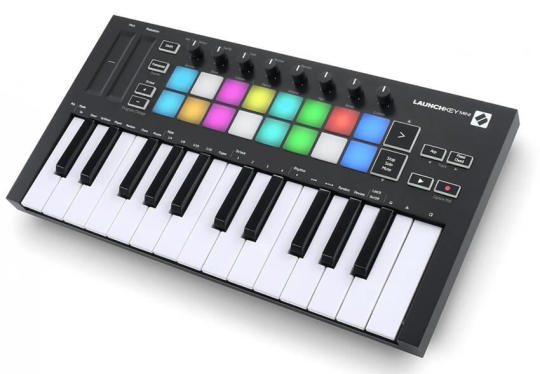
Compatibility: PC, Mac, iOS
No of Keys: 25
Key size: Mini
Key type: velocity-sensitive
Controls: Octave shift, Transpose, Pitch and Modulation strips, 16 velocity-sensitive backlit RGB launch pads, 8 rotary encoders, 10 function buttons
Connectivity: USB B port, 3.5mm TRS Type A MIDI out, Sustain Pedal input
Power: USB
Software: Ableton Live Lite, two months of Splice Sounds, AAS Session Bundle, Softube Time & Tone, Spitfire Audio LABS Expressive Strings, Klevgrand DAW Cassette and R0Verb, XLN Audio Addictive Keys, membership of Novation Sound Collective
Dimensions (mm): 330 x 172 x 40
Weight (kg): 0.69
The Launchkey Mini Mk3 is a powerful pocket-sized controller that is packed with features. Many of these features were missing from the previous version, including pitch bend and modulation touchstrips, a hardware MIDI out on a TRS jack, an incredibly flexible and versatile arpeggiator, a chord memory feature, and a great software bundle.
The Launchkey Mini Mk3 is a great keyboard controller for Live users, but it doesn't work perfectly with every DAW. If you're looking for the best solution at this price point, the Launchkey Mini Mk3 is definitely the way to go.
The Launchkey Mini MK3 is a great choice for a small, velocity-sensitive MIDI keyboard. It has an impressive range of connectivity options, making it perfect for traveling or using in a variety of settings.
3. Akai MPK Mini Mk3

Compatibility: Mac/PC/iOS
No of Keys: 25
Key size: Mini
Key type: velocity-sensitive
Controls: Eight assignable encoders, eight MPC pads, full transport controls, 4-way joystick
Connectivity: USB
Power: Bus-powered
Software: MPC Beats, Bassline, Tubesynth, Electric, Hybrid 3, Mini Grand, Velvet
Dimensions (mm): 32 x 18 x 4 cm
Weight (kg): 750g
The Akai MPK Mini Mk3 is a great MIDI keyboard for most people, particularly those looking for a quick and easy way to add melodies, basslines and simple chords to their projects. It's small and easy to use, with a ton of features that make it perfect for musicians of all levels.
The MPK Mini MK3 is much more than just a keyboard. It also has eight encoder knobs which can be easily mapped to any parameter of your DAW, and eight full-sized MPC style drum pads. This makes it an ideal controller for studio use or live performances.
At its heart, the Nano studio is a portable production powerhouse. Its small size makes it easy to transport, while its wealth of features and functions make it a valuable addition to any studio setup. Whether you need to record vocals, guitars, or other instruments, the Nano studio has you covered. Plus, its intuitive controls make it easy to use, even for beginners. So if you're looking for a versatile and portable recording solution, the Nano studio is definitely worth considering.
4. IK Multimedia iRig Keys 2 Mini

Compatibility: Mac/PC
No of Keys: 25
Key size: Mini
Key type: Velocity sensitive
Controls: Volume, Octave up/down buttons, Program up/down buttons, Setup button, assignable data push encoder, 4+4 assignable knobs, Modulation
Connectivity: MIDI in/out, micro-USB, 1/8" headphones output
Power: USB
Software: iOS SampleTank, Syntronik Pro-V Cubasis LE. Mac/PC: SampleTank 4 SE plus one of your choice from seven titles
Dimensions (mm): 32 x 14 x 5 cm
Weight (kg): 0.58kg
The Keys 2 Mini 25 is a small and affordable keyboard that has 25 mini keys. It is one of the smallest and cheapest models in the iRig Keys range, which also features keyboards with 37 mini keys and Pro (37 full-sized key) options. Mini 2 25 is small enough to place on any desktop, and it is sturdy enough to stay in place. It also features direct connectivity to iOS devices.
The keyboard has a variety of controls that you can use to customize your sound. These include the standard controls such as volume and pitch, as well as more advanced options like MIDI assignments and editing. The keyboard also has a set of program buttons, assignable rotaries, and a data knob to give you easy access to all of its features.
The keyboard is solid and well-sprung, although it may not be the player's dream come true. There are no dedicated pitch-bend or modulation dials, but if this is important to you, there are workarounds that you can explore deeper with Edit Mode.
The Irig Keys 2 is a great keyboard controller that is a bit on the expensive side. This offers many of the same features at a smaller size and for less money. Plus, it comes with a decent software bundle.
5. Native Instruments Komplete Kontrol M32

Compatibility: PC, Mac
No of Keys: 32
Key size: Mini
Key type: Velocity-sensitive
Controls: Eight touch-sensitive control knobs, two touch strips, four-directional push encoder
Connectivity: USB
Power: USB
Size: 47.5 x 16.7 x 0.5cm
Weight (kg): 1.45kg
The Komplete Kontrol A-Series is a USB 2.0 bus-powered keyboard that manages to squeeze 32 mini keys and the full complement of Komplete Kontrol controls into its tiny frame. It delivers almost the same functionality as the Komplete Kontrol S-Series (see below), making it an excellent mobile option for producers on the go.
The Komplete Kontrol M32 replaced the pitch and modulation controls with a pair of short touch strips. Also, the controller is equipped with 8 capacitive knobs, a 4d encoder, as well as numerous buttons that are incomparable in their tactile sensations. All this provides a high comfort of control, working with the operating Maschine, as well as using the interface of your DAW.
The OLED display and Smart Play features from the A-Series are also in place on the B-Series, allowing you to scale snap, chord trigger and arpeggiate with ease. As a regular MIDI controller keyboard, it also works with any other software.
The mini keys were the only downside to this keyboard for us. We found that we could live with them after some getting used to them, so if you can live with them too, this is the best portable and affordable MIDI keyboard you can buy.
6. Korg microKEY2 Air-25

Compatibility: PC, Mac, iOS
No of Keys: 25
Key size: Mini
Key type: Velocity-sensitive
Controls:Joystick, Arpeggiator button, Sustain/TAP button, Octave Shift buttons
Connectivity: USB, Bluetooth
Power: USB or batteries
Size: 39.5 x 13.1 x 0.52cm
Weight (kg): 0.67kg
The line of microKey 2 Air midi keyboards is represented by 4 models depending on the number of notes: 25, 37, 49 and 61. Each works via Bluetooth communication. Power is supplied via AA batteries or via USB.
If you're looking for a MIDI controller keyboard that's easy to set up and operate, the microKey 2 Air 25 is a great option. It may not have as many bells and whistles as some of its rivals, but it delivers on the basics, and plays far better than many other keyboards in its class.
7. M-Audio Oxygen 49 MKV

Compatibility: Mac/PC
No of Keys: 49
Key size: Full-sized
Key type: Velocity sensitive
Controls: 8 velocity-sensitive trigger pads, 8 assignable knobs, 9 assignable faders, transport buttons
Connectivity: USB, sustain pedal
Power: USB
Software: Ableton Live Lite, MPC Beats, Skoove and Melodics instrument learning, Air Hybrid 3 and Mini Grand instruments
Dimensions (mm): 81 x 24 x 9 cm
Weight (kg): 2.9kg
The Oxygen 49 MIDI keyboard controller is a lower-priced alternative to the M-Audio Pro 49. It has a 3-segment LED display, instead of the OLED display on the Pro, and it has 8 back-lit red pads instead of 16 multi-coloured ones. However, it still provides access to 16 sound sources from the front panel when programming.
The Oxygen 49 lacks a dedicated MIDI out port, but it does have other features that make it stand out from the crowd. These functions are mostly triggered via soft keys and via 'secondary modes' from the keybed itself.
Read the full article
4 notes
·
View notes
Text
Uvi grand piano model d aurturia
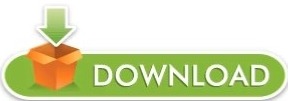
#UVI GRAND PIANO MODEL D AURTURIA FULL#
#UVI GRAND PIANO MODEL D AURTURIA SOFTWARE#
MicroLab’s rubberized case isn’t just for show, it also protects your controller when you’re on the move, and lets you efficiently store your USB cable. Arturia KeyLab Essentials 49 & 61 Black Editions.
#UVI GRAND PIANO MODEL D AURTURIA FULL#
A full music production package is included too.Įveryone hates loose cables, so MicroLab features an integrated cable-tidy recess to keep your setup neat, and make storage and travelling quick and easy. UVI GRAND PIANO MODEL D: a beautifully sampled Steinway classic. UVI Grand is a recreation of the Steinway Model D piano. Want to get hands on with your music software? MicroLab gives you instant, effective control, letting you play all your soft-synths and virtual instruments, wherever, whenever. Arturia MiniLab MkII MiniLab MkII is an essential tool for musicians on the move and studios. Sustain notes with a button, play chords with one note, swipe through presets and tap to select. With just 4 buttons and 2 touch strips, MicroLab still gives you a remarkable level of control. The included UVI Grand Piano Model D instrument is the go-to for world-class piano sounds, and record and arrange it all in Bitwig 8-Track.
#UVI GRAND PIANO MODEL D AURTURIA SOFTWARE#
MicroLab comes with Analog Lab Lite, an award-winning software instrument bundle with over 600 presets of legendary synthesizer and keyboard sounds. It features the same keybed as our award-winning KeyStep it’s responsive, velocity-sensitive, and feels great to play. This sample-based virtual instrument has captured the sound of a classic Steinway Model D in meticulous detail, putting that rich, evocative tone at disposal. Unlike other mini-key controllers, you’ll actually enjoy playing MicroLab. A stunningly sampled piano legend Arturia teamed up with virtual instrument developers UVI to include the truly excellent Grand Piano Model D with MiniLab MkII.
2 touch strips for pitch bend, preset browsing, modulation and more.
Buttons for octaves, chord mode and secondary functions.
Full production software included: award-winning Analog Lab Lite software instrument bundle with over 600 synthesizer and keyboard sounds, UVI Grand Piano for classic piano sounds.
25 velocity-sensitive mini-keys with the best action keybed.
Main features of the Arturia Microlab include: Free Software Title Include: Arturia Analog Lab 2, Ableton Live Lite, UVI Grand Piano Model D USB Bus Powered, DC PSU (Sold Separately) 230521 49 keys Non. The keyboard is responsive, velocity-sensitive and feels great to play, and has loads of smart design features like a rubber bumper for protection on-the-go, and an integrated USB cable keeping everything neat for travel. It's easy to install, comes with a full production software suite including Analog Lab Lite, and Bitwig for recording your creations. Arturia MicroLab is an excellent little 25-key controller with the best quality mini-key keybed. Software Specifications: Includes Analog Lab software with 6000 synth sounds Includes Ableton Live Lite Includes UVI Grand Piano model D.

0 notes
Text
Ableton 10 suite come with max for live
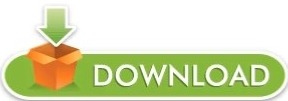
#Ableton 10 suite come with max for live manual#
#Ableton 10 suite come with max for live full#
#Ableton 10 suite come with max for live pro#
#Ableton 10 suite come with max for live windows#
With the Launchkey MK3 control surface script, it is now possible to continue playback by holding down the Shift button and pressing the Play button.
#Ableton 10 suite come with max for live pro#
Fixed an issue where starting playback via the Novation Launchkey Mini MK3, Launchkey MK3 or Launchpad Pro MK3 control surface scripts could result in MIDI notes getting cut off.
Fixes a bug that caused Live to enable the Warp switch and to reset the audible region of unwarped audio clips when locating missing samples or replacing sample files on disk under certain circumstances.
Audio hangs if in Live 9 created Simple Delay clip automation on audio track is changed in the Delay Device.
Updated the bundled Max build to version 8.1.10.
Users should see more reliable engine performance on machines with the Apple M1 CPU.
Live is compatible with Apple Silicon computers running Rosetta.
Live now supports macOS 11 Big Sur using Intel based hardware.
Also fixed a crash that could occur when right-clicking in the MIDI Note Editor while the Note Expression tab was open, and selecting "Pitch Bend Range Settings.".
Fixed a crash that could occur during video export when using an external display as the primary display on MacBook Pro (macOS).
Previously, all User Remote Scripts were named 'GenericScript' from the perspective of Max for Live.
Where possible, the name given to a User Remote Script's folder (the name visible in Live's Control Surface menus) will now be visible to Max for Live.
Fixed an issue with User Remote Scripts where the SendsMapMode and MasterSliderChannel settings in UserConfiguration.txt were ignored.
vstpreset files for certain presets which previously failed to be displayed or supported.
Fixed an issue where the Session frame of the ATOMSQ control surface script was visible even when the hardware was not connected.
Fixed an issue where the Track Solo feature of the Tranzport control surface script did not work correctly.
Previously, installing many Live Packs at once caused Live's installation dialog window to become too big and unable to be used properly.
Previously, under certain circumstances, Live appeared to hang because the UI could not be drawn.
Full Screen mode is still available using the "F11" key.
#Ableton 10 suite come with max for live full#
On Windows, using the "Alt"+"Enter" keys to enter Full Screen mode is now disabled.Grouping (and ungrouping) within the device chain will now behave as expected. Alternatively, if grouped prior to setting the MIDI routing between the two, Live would also crash when attempting to ungroup the pair once the routing was set. Fixed a crash that would occur when trying to group an External Instrument and an audio effect receiving MIDI from that External Instrument.On Windows, Live once again detects if it could not create a directory because one already existed.Fixed an issue where Live hangs when zooming in Arrangement View in some case.Updated the bundled Max build to version 8.1.11.The Arturia KeyLab 49/61/88 control surfaces once again work as expected.
#Ableton 10 suite come with max for live windows#
On Windows, pressing "Alt" in Live now shows Menu Accelerator Keys to open menu bar items, as is the behavior in standard Windows applications.
When using the Novation Launchkey MK3 or Launchkey Mini MK3 control surface script, the Record Button will now toggle the Arrangement Record Button when in Arrangement View.
#Ableton 10 suite come with max for live manual#
The Faderport 16 still requires manual setup, but Faderport 16 and 16 XT will appear in the control surface dropdown menu.
The PreSonus Faderport and Faderport 8 will be autodetected by Live.
On the Arturia KeyLab MkII, the master fader button will cycle the mapping of the encoders between Pan, Send A, Send B, and device parameters.
Fixed an issue where the Session frame was visible even when the hardware was not connected.
The Buttons beneath the Faders can now control multiple features (Track Arming, Track Muting, Track Soloing and Track Selection) that can be toggled.
The Pads now provide LED feedback in respect to Clip/Clip Slot states in Live.
Live's Takeover feature is now enforced for the Knobs and Faders when switching between DAW and Preset Modes.
Additionally, it is possible to toggle between controlling Send A and Send Bīy holding down Shift and pressing the SENDS Pad.
The Knobs can now control multiple features (Device parameters, Track Panning, Track Sends and, in the case of the 25 key, Track Volume) that can be selectedīy holding down Shift and pressing the Pads used for DAW KNOB CONTROL.
Holding the Encoder down and turning it will scroll the selected Scene up and down.
Turning the Encoder will now scroll the Session frame up and down.
The Rewind and Fastforward buttons will now rewind and fastforward the Arrangement position.
The functionality of the Oxygen Pro control surface script has been drastically changed.
Added control surface support for the Roland Fantom.Īdded control surface support for the M-Audio Hammer 88 Pro, Oxygen Pro Mini and Oxygen MKV Series.

1 note
·
View note
Text
Arturia keylab 61 bedienungsanleitung
ARTURIA KEYLAB 61 BEDIENUNGSANLEITUNG >> DOWNLOAD LINK
vk.cc/c7jKeU
ARTURIA KEYLAB 61 BEDIENUNGSANLEITUNG >> READ ONLINE
bit.do/fSmfG
arturia keylab essential 49arturia keylab essential 61
arturia keylab 61 mk2 bedienungsanleitung deutsch
arturia midi control center
Bedienungsanleitung. Sehen Sie sich hier kostenlos das Handbuch für Arturia Keylab 61 MkII an. Dieses Handbuch fällt unter die Kategorie Midi-Tastaturen und View and download the Manual of Arturia Keylab MKII 61 Keyboard (page 64 of 98) (German). Also support or get the manual by email.Suchen Sie eine Bedienungsanleitung zu Arturia KeyLab 61? Sehen Sie sich hier die Bedienungsanleitung des Produktes sofort und kostenlos an. 2. GUIDED TOUR 2.1. Tastatur KeyLab Essential verfügt über 49 bzw. 61 anschlagdynamische, leichtgewichtete Tasten. Neben der offensichtlichen Funktion, nämlich In the next part of the manual, we'll take a look at the options available for each the controls. 16 Arturia - User Manual KeyLab Essential - MIDI Control
https://sefowowama.tumblr.com/post/691789483223449600/canon-mx490-scannen-pdf, https://qelacukid.tumblr.com/post/691790163116949504/vsx-933-manual, https://sefowowama.tumblr.com/post/691789301048115200/abus-alarmanlage-bedienungsanleitung-target, https://qelacukid.tumblr.com/post/691789498763345920/smartwares-co-detector-bedienungsanleitung, https://qelacukid.tumblr.com/post/691789369155239936/ingersoll-bison-28-bedienungsanleitung-deutsch.
0 notes
Text
Progress report
It's been quiet here, but my research continues. Here's the gear at the top of my wishlist now:
Korg Minilogue: Decided to spring for polyphonic because it has the sequencer and it seems worthwhile instead of limiting myself to monophonic from the jump. Aiming to get a deal on something used, and let a couple slip through my fingers on eBay for like $300-ish recently, which seems like a viable price point. Wildcard: I almost bought a used MS-20 for $300, and if one comes up at that price again, I might do it.
Korg Volca Beats: Honestly, still not even clear on whether I really need/want a drum machine, but this one seems like so much fun, and it's affordable. Watching prices on things like a Behringer RD-8, too, but I can grab a $150 Volca Beats anywhere.
Arturia KeyLab 49 Essential: Had to look up the model three times to make sure this is the one I want, but since I want the Arturia Lab Farfisa V sound, and I need, like, more than 25 keys to comfortably play that, I want a new MIDI controller with some knobs and switches, and buying this new for $200 comes with some (all?) of the Arturia Lab stuff (and if not, the Farfisa is on sale for $75 rn) and some flavor of Ableton Lite license, that seems like a bargain as long as I buy it new.
Focusrite Scarlett 2i2: Need an audio interface, and I think I need it to handle two inputs. Around $200 new.
That's kinda it, other than a vicious tangle of cables and power supplies that I don't really want to contemplate ahead of time too much who am I kidding there will be diagrams and I will probably tape out the space on my desk where everything belongs and oh I wonder if I need a bigger desk. And also, plants.
0 notes
Text
$50 OFF Arturia KeyLab Essential 49 Keyboard Controller • USA
$50 OFF Arturia KeyLab Essential 49 Keyboard Controller.
BUY HERE
#Arturia KeyLab Essential 49 Keyboard Controller#Arturia KeyLab#Keyboard Controller#MIDI keyboard#MIDI#keyboard#MIDI Controller#Arturia
0 notes
Photo
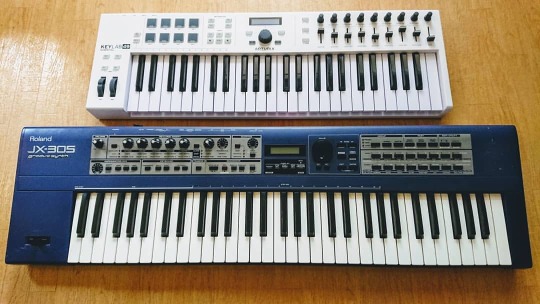
My Arturia KeyLab Essential 49 MIDI keyboard 2017 & Roland JX-305 Groovesynth synthesizer 1998 🎹 🔥 #keylab #jx305 #rolandjx305 #producer #producerlife #arturia #roland #instadaily #music #musicproducer #musician #artist #synthesizer #studiolife #daily #production #synthporn #synth #keyboard (paikassa Kuopio, Finland) https://www.instagram.com/p/CDlMjBFDkRB/?igshid=7xl009z4x11r
#keylab#jx305#rolandjx305#producer#producerlife#arturia#roland#instadaily#music#musicproducer#musician#artist#synthesizer#studiolife#daily#production#synthporn#synth#keyboard
1 note
·
View note
Photo
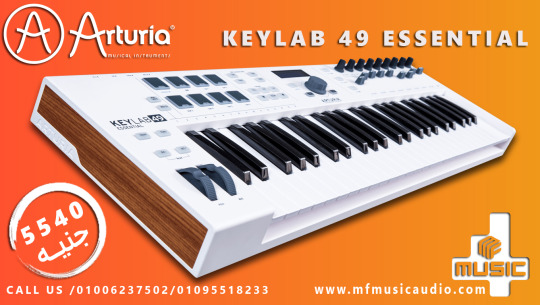
Arturia KeyLab Essential 49 49-key Keyboard Controller
There are few more frustrating things than when you want to sit down and make music but find yourself sinking all your time and efforts into finding inspiring sounds or, worse yet, getting your system to work at all. Arturia's KeyLab Essential 49 is a virtual instrument workstation that's perfect for preventing exactly that sort of problem from derailing you. Between the controller's top-notch keybed, comprehensive hands-on controls, and total integration with the thousands of sounds in Arturia's Analog Lab software, KeyLab Essential just plain works. It's an amazing experience that lets you take your ideas and turn them into fresh tracks in no time.
Cut out the technical tedium with KeyLab Essential by combining a beautifully playable controller keyboard with Arturia's acclaimed Analog Lab. When we got our hands on this amazing setup, even the most seasoned soft-synth gurus at Sweetwater couldn't believe how easy it was to use this streamlined system. For starters, there's the onboard Analog Remote section, which lets you call up sounds right from the controller — no need to touch the mouse. You have pre-mapped knobs and sliders for parameter control, performance pads, and even tools like chord mode to make songwriting as simple as it gets.
Powerful as it is, Analog Lab is just part of what KeyLab Essential has to offer. This wonderfully laid out controller keyboard includes all the control you need to take charge of your DAW, including full transport controls. In fact, KeyLab Essential is a fully loaded universal MIDI controller, so it's completely compatible with any third-party instruments or other music-creation software. Most of the controls also do double duty, providing you with layers of control over Analog Lab, your DAW, and any other instruments you want to play with.
Speaking of DAW applications and other virtual instruments, check out the awesome software package bundled with KeyLab Essential controller keyboards. Let's start by taking a closer look at Analog Lab. This greatest-hits sound collection features many of the top classics from Arturia's award-winning V Collection. It covers 17 timeless synths and over 6,500 sounds featuring Arturia's amazing True Analog Emulation technology. Next, there's Ableton Live Lite. It's an ideal introduction to one of the world's most popular creative DAWs, which is renowned for its powerful songwriting structure. Lastly, there's UVI's Grand Piano Model D, a meticulously captured Steinway Model D that adds an essential instrument to your keyboard collection.
لطلب شراء المنتج و الشحن اتصل بنا على الارقام التالية☎01006237502 ☎01227545903☎01127214405 ☎01095518233 ✅ضمان ضد عيوب الصناعه لو حابب تعرف أكتر عن المنتجات أو تشوف أكتر تقدر تزور موقعنا الرسمي 👇https://mfmusicaudio.com/ومن خلاله تقدر تعمل أوردر يوصلك لحد باب البيت في أسرع وقت أو تشرفنا بفرع الشركة : 217 شارع احمد زكي - المعادي ميدان فايدة كامل امام سنتر الهدي والنور تقدر تدخل علي صفحاتنا الرسمية علي فيسبوك وتعرف أكتر عن المنتجات من خلال الروابط👇https://www.facebook.com/mfmusicalinstrumentsegypt/https://www.facebook.com/mfaudiostoreطرق الدفع لدينا:متوفر دفع بالفيزا كارد و الماستر كارد مع ميزة انك تقدر تقسط اي منتج مع البنك الاهلي المصري بدون فوائد لمدة 6 شهورو خدمة QR و المحفظة الذكية و فودافون و اورانج كاش هدفنا: الثقة - التميز - الأبداع - العمل علي راحة العميل
0 notes
Photo
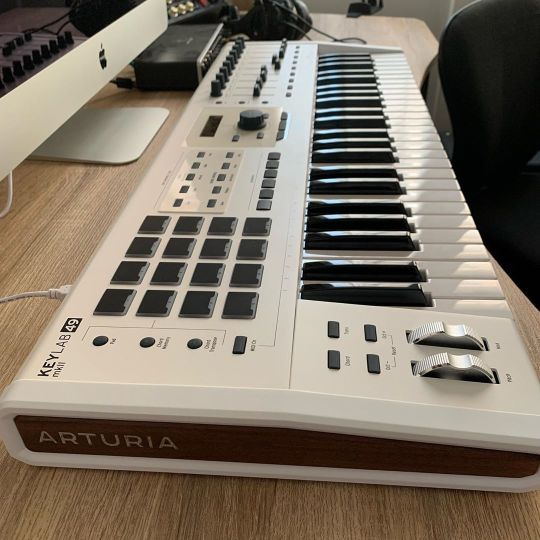
Studio update: Arturia Keylab 49 Mk II. Making MIDI programming easier #arturia #arturiakeylab49 #homestudio #newgearday https://www.instagram.com/p/CAz6xdsqpOE/?igshid=1s0enu3i63oe6
0 notes
Text
What to buy if you want to start producing music at home
By now, you've no doubt heard that the Grammy-winning song of the year and record of the year were not recorded in some giant studio loaded with over-priced, pro-grade gear. Instead a brother and sister duo recorded them in a bedroom at their parents' house, primarily using tools available to the average hobbyist. (The $2,000-ish audio interface being an obvious exception.) It's not news that the tools of creation or the avenues for distributing art are accessible to more people than ever. But this weekend, Billie Eilish and her brother Finneas proved that the cultural institutions that have dominated popular music for so long can no longer ignore the bedroom producer or budding Soundcloud star.
Maybe you've even been inspired to build your own home recording studio. And maybe, you're not quite sure where to start. Well, an audio interface, a good mic and a decent set of headphones will get you pretty far. But the first thing you'll need is probably staring you right in the face: a computer.
Justin DeLay, Director of Product and Category Marketing at Reverb, drives home just how important the computer is: "You can strip away everything else and as long as you have a computer you can still create music," he told me. He suggests you "spend the money on a good computer and get other gear -- such as audio interfaces, mics, headphones, etc. -- used or at reasonable price points."
But, truthfully, you can do quite a lot with whatever computer you have on hand. Joe Pecora, the engineer and producer at Red Room Studio, says your set up "could be as simple as an iPhone/iPad with Garage band." (I know someone who recorded an entire album this way.) While he agrees that the most important part is your computer, he argues it doesn't have to be super powerful. It doesn't even have to be a desktop. JDilla famously created many of his beats on a Roland SP303, and you can basically recreate that experience with an iPad and the $4 Koala Sampler for iOS. And don't forget that Gorillaz recorded an entire album on an iPad.
Which leads us to the next thing you'll need: a DAW, or digital audio workstation. If you're a Mac user, then you're lucky enough to have access to Garage Band, a surprisingly capable free option. And upgrading to Logic Pro X, the same DAW used to record When We All Fall Asleep, Where Do We Go?, is only a $200 investment. If you're on Windows (or just don't like Logic), I often recommend Ableton Live (starting at $99). But honestly there are plenty of great options out there, like FL Studio, BitWig and Cubase all of which start at $99. And often, stripped down versions come free as part of a software bundle when you buy music-making hardware like MIDI controllers and audio interfaces.
What to buy
Expand
Assuming you already have a computer and you just need the accessories to get recording here's a list of surprisingly capable gear at beginner-friendly price points. While picking up everything here new will set you back about $400, you could find it all for as little as $250 used if you're patient.
Focusrite Scarlett Solo - $109
Sony MDR-7506 - $90
Arturia Minilab - $109
Audio-Technica AT2020 - $99
Speaking of which, one of the first additions to your studio should be a MIDI controller. DeLay says this is a piece of gear often overlooked by beginners. "It's not just for playing keyboard sounds," he explained, "it can be used to write drums and percussion, to control mixes and more. It's the creative interface of music production, and you don't have to play the piano in order to harness its power."
We've covered plenty of affordable and portable options before. But if you don't plan to make music on the go, I can't recommend the Arturia Minilab enough. It's just $109, punches well above its weight, and even the pros love this thing. And if you have the space, it's not much more to upgrade to something like the Keylab Essential 49 ($209) or Novation Launchkey 49 ($199), which will give you a lot more controls to play with.
Obviously part of what makes Billie Eilish so captivating is her voice. There's no gear that will magically turn you into a breathy pop goddess, but a decent mic and audio interface can at least help you sound your best. Now, you could get a USB microphone, like the $130 Blue Microphones Yeti, and it will certainly get the job done. Heck, that album I mentioned earlier was recorded using the wired headset that came with the iPhone.
But, honestly, your better bet is to get a regular XLR mic and an audio interface. This is a place where Eilish and her brother really splurged, but that doesn't mean you have to. In fact, Pecora specifically warns against this. "People will look at their favorite artist and see that they use a certain mic or preamp or plugin and want to use the same thing thinking it will get them the same sound." And, in fact, on early singles like "Ocean Eyes" Eilish was using an Audio-Technica AT2020 condenser mic, which costs just $100. But if you fancy yourself a future pop sensation and want to make sure your vocals are the star of the show, consider using a significant chunk of your budget on something like the Rode NT1-A ($200) or Shure SM7B ($399).
As for the interface, there are tons of great options out there. But bang for your buck, it's hard to beat the Scarlett series from Focusrite (just make sure to get the second- or third-gen models). You can get the Scarlett 2i2 for under $100 used, but it's just $160 new (and includes a huge bundle of very useful software).
The reason to opt for an audio interface instead of a simple USB mic is because it offers you a lot more flexibility and room to grow. For one, it offloads a lot of the audio processing from the CPU. Second, it will allow you to connect not just mics (and swap in different ones for different purposes), but also instruments, turntables or anything with an audio-out jack. An audio interface is also necessary if you plan to connect a pair of studio monitors.
This is an area that DeLay advises caution. While a good set of studio monitors will obviously be better than the speakers on your laptop and will result in a better mix, it's too easy to get caught up in what he calls monitor envy. "The reality is that monitors at a $300 price point are going to work just fine in most spaces," he says. Plus, your bedroom probably doesn't have the space to really make the most of large, powerful monitors. So, save your money.
And if you're just starting out, you're probably better off getting a decent set of headphones. There're tons of amazing and affordable studio quality headphones out there for under $200, like the $179 Beyerdynamic DT990PRO (currently down to just $132 on Amazon). But one of our favorites is an old workhorse from Sony, the MDR-7506. They're well under $100 and actual pros have used them for decades to mix music.
One tip DeLay offers for novices: Double check your mixes in the real world. Headphones can over emphasize bass, while smaller studio monitors can have trouble delivering accurate bass response. So make sure to listen to your track on laptop speakers or in a car to get a sense of how it will sound in the wild.
And that's really the key -- have the patience to develop your skills and make the most of the gear you have. It's really easy to catch a bad case of GAS (gear acquisition syndrome) when you're first starting out -- trust me, I know. But there's no need to shell out thousands of dollars for high-end gear to start making music. You don't even need to buy new gear. Pecora suggests the only thing you absolutely should buy new is headphones. And, presumably, that's just because you don't want to be wearing years worth of someone else's sweat on your ears.
Images: Getty Creative (home studio); Ableton (Ableton Live running on laptop); Focusrite (Scarlett Solo); Will Lipman / Engadget (Arturia KeyStep, Sony MDR-7506)
- Repost from: engadget Post
0 notes
Video
'Million Nights'... Produced by up and coming artist @noellanix hailing from Gold Coast, Austrailia! Read below to see what makes the magic happen! #Vocals recorded with RØDE K2 @rodemic Additional audio RØDE Videomic Pro+ MIDI: Keylab 49 @arturia_official VST: Analog Lab 2 @arturia_official DAW: Live 9 @ableton Monitors: HS7's @yamahamusicusa Headphones: ATH-MX50x @Audiotechnicausa Interface: Scarlett 2i2 @wearefocusrite . . . . . . . . . . #musicproducer #singer #songwriter #singing #producerlife #homestudio #recordingstudio #rodemic #goldcoast #vocalist #trap #rnb #vibe #musically #beats #instrumentals #studiolife #femaleproducer #bmxlove #synths #ridebmx #creative #bmxgirl #bmxer #bmx #bmxlife #flatlandbmx #flatland #arturia
#musicproducer#vocals#arturia#songwriter#trap#flatlandbmx#singing#bmxlife#rnb#bmx#vibe#beats#singer#bmxgirl#goldcoast#vocalist#musically#ridebmx#recordingstudio#homestudio#bmxer#studiolife#femaleproducer#bmxlove#producerlife#rodemic#instrumentals#flatland#creative#synths
1 note
·
View note
Photo
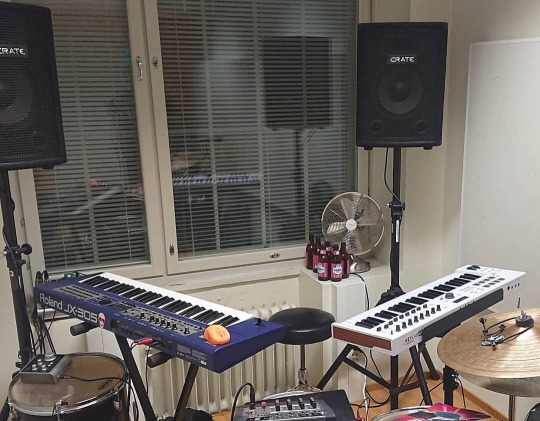
Roland JX-305 & Arturia KeyLab 49 🎵 🔥 . . . . . #rolandjx305 #roland #arturia #keylab #keylab49 #arturiakeylab #synthesizer #studiolife #producerlife #synthporn #synth (paikassa Helsinki) https://www.instagram.com/p/CKDRXmyDp7w/?igshid=1li53d7j4balj
#rolandjx305#roland#arturia#keylab#keylab49#arturiakeylab#synthesizer#studiolife#producerlife#synthporn#synth
0 notes
Link
0 notes
Photo
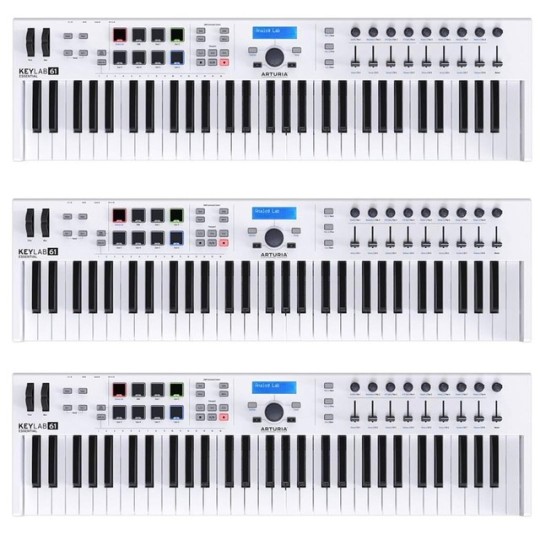
@arturia_official keylab 49/61 Essential #synthjam #synth #synths #arturia #daw #control #controller #messe #messe2017 #musikmesse #musikmesse17 #software #studio
#synths#arturia#musikmesse17#musikmesse#controller#synth#software#studio#messe2017#control#messe#synthjam#daw
11 notes
·
View notes
Text
The 10 Best DAW Controllers for Hands-On Production
The 10 Best DAW Controllers for Hands-On Production: via LANDR Blog
The modern DAW is one of the most powerful tools artists and producers have to create music.
But with all this power comes some pretty severe limitations and pitfalls.
Working on a computer screen solely with a mouse and keyboard just doesn’t offer the same tactile experience of the analog consoles of studios’ past.
Working on a computer screen solely with a mouse and keyboard just doesn’t offer the same tactile experience of the analog consoles of studios’ past.
That’s why MIDI-enabled DAW controllers are hugely popular with producers from beginner to professional.
In today’s DAW controller market there’s something out there for everyone, no matter what your specific needs are for producing your tracks.
In this article, we’ll look at the best DAW controllers for producers at all levels.
Here’s the 10 best DAW controllers on the market right now.
1. Ableton Push 2
Coming in at number one is the Ableton Push 2.
This MIDI controller does a lot more than just control parameters in Ableton.
It essentially makes it possible to move everything about your production workflow off the computer screen.
The user-friendly interface makes it easy to perform a variety of tasks like writing drum loops, chopping samples, playing scales, mixing and performing live–to name a few.
It’s the most well-integrated DAW controller on this list because it was designed specifically for Ableton.
It’s the most well-integrated DAW controller on this list because it was designed specifically for Ableton.
If you want an all-in-one DAW controller that can do just about anything and keep you from staring at a computer screen, the Ableton Push 2 should be high on your list.
Pros:
The best-optimized controller for Ableton
Groundbreaking technology that takes you completely out of the DAW
Cons:
Only works with Ableton
Somewhat expensive
2. Arturia Keylab Mk2
The Arturia Keylab series is an excellent place to start if you’re looking for a MIDI keyboard that doubles as a DAW controller.
The Keylab Mk2 comes in a variety of keyboard sizes, so depending on your budget and needs you can get a 49, 61 or 88 key version.
The Mk2 version comes in a solid aluminum build and even includes aftertouch to distinguish itself from its more affordable plastic-cased Keylab Essentials cousin.
The Keylab series all come with pads, sliders and knobs that are mappable to your DAW.
In the Mk2’s case, it comes with 16 pads and 10 sliders and knobs.
Any of Arturia’s Keylab series is a great option for controlling your DAW because they come bundled with access to Arturia’s V plugins, a big selection of re-imagined vintage synth VSTs.
For a solid DAW controller with a great keyboard that integrates with any DAW, you should definitely consider the Mk2 or any more affordable member of the Keylab family.
Pros:
Rock-solid design and smart interface
Free access to Arturia VSTs
Cons:
Expensive but there are less pricey Arturia Keylab options that are comparable
3. Icon QCON
The Icon QCON is the Cadillac of DAW controllers.
It essentially turns your DAW setup into a professional-looking studio with the look and feel of a vintage Neve console.
It’s perfectly designed for mixing and postproduction with automated sliders that physically move according to the levels set in your DAW.
It also comes with a transport section and navigation wheel that makes it easy to find and zoom in on the precise section of track you’re working on.
With flashy level meters, meticulously built faders and knobs, you’ll want the Icon QCON if you’re looking to use your DAW as a commercial console without investing in an expensive analog console.
The Icon QCON is the Cadillac of DAW controllers.
Pros:
Comprehensive control of your DAW
Console-like feel
Cons:
Very expensive
4. Novation Launchpad Pro
The Novation Launchpad Pro is the predecessor to the Ableton Push 2.
Anyone who compares the two will instantly notice their similar look and feel.
It has the same number of push pads less the interactive LCD screens that the Ableton Push uses to put its capabilities into the hardware space.
While it’s not a Push, the Launchpad Pro has a ton of functionality because it integrates with all DAWs and even hardware, not just Ableton.
It also includes useful buttons that map to different functions like a sequencer, chord mode, pan, sends, and a lot more.
It’s a more affordable version of the Push 2 but it still packs a lot of punch and is a great option for anyone looking to produce music without relying so heavily on the DAW interface.
Pros:
Affordable alternative to the Push
High-quality build
Integrates with most DAWs
Cons:
Not quite ready to completely move you out of the DAW
5. MPK Mini MkII
The Akai MPK Mini is one of the more popular DAW controllers on the market right now.
It’s an affordable MIDI keyboard that comes with eight drum pads and eight mappable knobs.
While it’s easily compared to the Launchkey MINI and the Minilab, it sets itself apart with its joystick control that can be used to modulate pitch and other parameters.
Another defining feature is its sustain input which makes it possible to hook up a foot pedal for added control.
It also includes an arpeggiator sequencer, which makes it very useful for working with hardware synths.
Pros:
Uses legendary MPC drum pads
Good keyfeel and controller stick
Sustain input
Cons:
Cheaper quality build
Less optimized for Ableton than the Launchkey Mini
6. Launchkey Mini Mk3
There’s a handful of mini key DAW controllers on the market right now, one of the most notable is Novation’s Launchkey.
Like most mini DAW controllers it comes with two octaves in mini keys, sixteen pads and eight mappable knobs.
However, the Launchkey Mini has all the trappings of a modern DAW controller which puts ahead of some of its older competition.
Just like the Launchpad, the Launchkey’s pad’s come with color-coded lights that map to reflect different parts of Ableton’s interface.
It also comes with a good arpeggiator and while it’s best optimized for Ableton, it also comes with great integration with other DAWs as well.
Pros:
Well rounded MIDI controller with good features and integrations
Optimized for use with Ableton
Cons:
Not as good of a key feel as other mini controllers
Better suited to finger drummers than keyboardists
7. Minilab Mk2
The most direct comparison to the Launchkey Mini Mk3 is the Minilab Mk2.
These are two very similar DAW controllers in terms of quality and build. Except that the Minilab comes with more knobs and fewer pads than the Launchkey.
The Minilab Mk2 doesn’t have a built-in arpeggiator like the Novation, so it’s not quite as good for controlling hardware synths–Arturia’s Keystep controller however is more set up for this application.
It makes up for not having an arpeggiator by bundling itself with the Analog Lab–a VST plugin collection with over 6000 synth sounds.
Pros:
Great key feel
Access to Arturia’s VST collection
Cons:
Less drum pads than other mini controllers
No arpeggiator
8. FaderPort 8
The Presonus FaderPort 8 is a DAW controller that focusses on the mixing side of music production.
It’s an affordable comparison to the Icon QCON.
It comes with eight fader controls that mechanically map to the settings in your DAW, meaning they move as you adjust them in your DAW.
Each fader comes with controls for adjusting pan, mute, solo and even editing plugins.
The FaderPort also includes a transport section and full console for zooming, scrolling, navigating your channel bank and more.
Considering its small footprint this console-style controller is quite versatile, of course, if you want more faders to get your hands on you can always upgrade to the larger format FaderPort 16.
Pros:
Affordable alternative to the more advanced QCON
Good transport and navigation controls
Cons:
Not a ton of faders unless you upgrade to the Faderport 16
Best optimized for Studio One over other DAWs
9. Launch Control XL
The Launch Control XL is a very simple version of the console-style DAW controller.
It has eight fader channels with three accompanying knobs for two sends and panning.
However, it’s possible to map to more sends and effects with the send select and device control buttons.
The Launch Control XL is mostly optimized for Ableton, but it can also be used with any DAW.
Its main weakness is that it lacks a dedicated transport and navigation section.
But, considering its affordable price this could be the right DAW controller if you’re getting started.
It’s a bit older so I’d especially recommend looking at the used market for this specific controller.
I’d especially recommend looking at the used market for this specific controller.
Pros:
Cheapest option for a mixing console controller
Decent integrations with most DAWs
Cons:
Small interface with limited features
10. Professional Fire
If you’re an FL Studio user you should take a look at the Akai Professional Fire since it’s the only DAW controller specifically designed for FL Studio.
This controller is mainly designed to match the sequencer interface that FL Studio is known for, it makes it easy to program beats on multiple channels and visually see your arrangement.
It also comes with knobs for adjusting the level, pan, filter and resonance of each mixer channel so you can use it within your mixing workflow too.
Also included is a transport section to help with streamlining production and recording.
The Professional Fire also functions as a MIDI keyboard and drum pad with it’s dedicated key and drum buttons.
Finally, you can use it for playing tracks in a live setting with its live performance mode.
For the aspiring FL Studio producer, this is an excellent option.
For the aspiring FL Studio producer, this is an excellent option.
Pros:
The best option for controllers specific to FL Studio
Cons:
More oriented for writing and creating than post-production
The post The 10 Best DAW Controllers for Hands-On Production appeared first on LANDR Blog.
from LANDR Blog https://blog.landr.com/daw-controller/
via https://www.youtube.com/user/corporatethief/playlists
from Steve Hart https://stevehartcom.tumblr.com/post/624828129679228928
0 notes